Old steamers


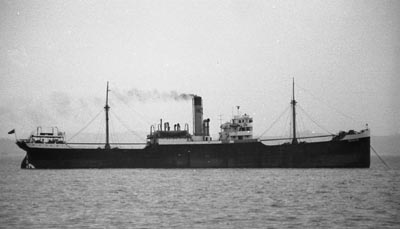 Nogales
Built in 1920 in the United Kingdom by Blyth Drydock Co.
Nogales
Built in 1920 in the United Kingdom by Blyth Drydock Co.
She was launched as War Obelisk and finished as Bachi for Naviera Bachi of Bilbao.
In 1936, at starting of Spanish War she was in Itlay where was confiscated and delivered to Compañía Garibaldi with the name Bologna and Italian flag.
On 27/01/37 was redelivered to her owners and got back her original name.
On 1951, together with the rest of the Bachi fleet, was transferred to Compañía Naviera Vascongada S.A. changing her name to Alejandro Zubizarreta.
On 1957 the same owners changed her name to Abasolo.
On 1960 was sold to Ramón Garzón González, radicated in Madrid, and in 1967 to Naviera de Cantabria S.A., who in 1970 changed her name to Nogales and the home port to Santander.
She was yet in the Lista Oficial de Buques of 1975-76, but this time her owners were Naviera Butrón.
She was 3,133 GRT, 5,200 DWT and the dimensions were 100.95 x 14.26 x 7.08 meters with a triple expansion alternative machine of 2,150 HP and 10 knots speed.
She seems that was broken up in 1977.

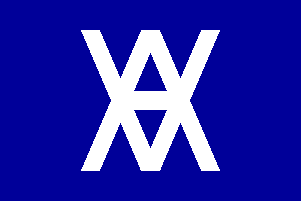
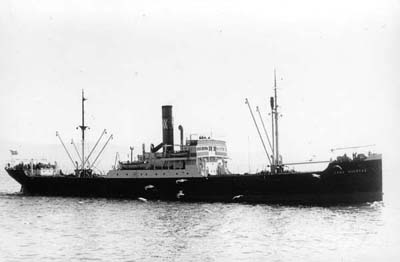 Cabo Huertas
Built by Sociedad Española de Contrucción Naval in Bilbao in 1922, as Cabo Huertas, was 2.779 GRT.
Cabo Huertas
Built by Sociedad Española de Contrucción Naval in Bilbao in 1922, as Cabo Huertas, was 2.779 GRT.
In 1938 changed her name to Tausend, but in 1939 is again Cabo Huertas with Ybarra y Compañia.
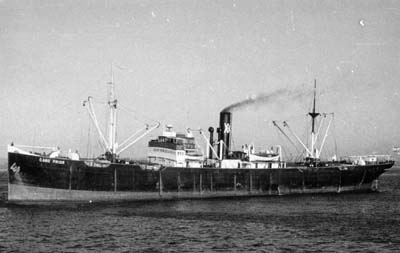 Cabo Prior
Built by Compañía Euskalduna in Bilbao in 1917 as Mar Tirreno, was 3,367 GRT.
Cabo Prior
Built by Compañía Euskalduna in Bilbao in 1917 as Mar Tirreno, was 3,367 GRT.
Later was Rio Tajo and in 1935 Cabo Prior, with Ybarra y Compañia.

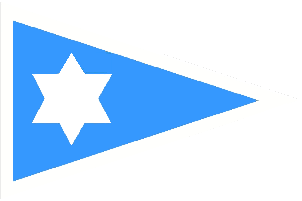
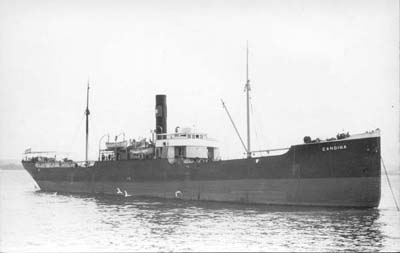 Candina
Built as Gloxinia in 1897 by Tyne Iron Shipbuilding Co. in Newcastle upon Tyne, was 2.587 GRT, 4.310 DWT and her dimensions were 96.89 x 13.23 x 6.24 meters.
Candina
Built as Gloxinia in 1897 by Tyne Iron Shipbuilding Co. in Newcastle upon Tyne, was 2.587 GRT, 4.310 DWT and her dimensions were 96.89 x 13.23 x 6.24 meters.
The main engine was a triple expansion steam machine with 1,300 HP and the speed 9.5 knots.
In 1916 was Petit Gaudet and in 1921 was bought by D. Miguel Victoriano Uravain y Larrainza, radicated in San Esteban de Pravia, who rechristened her as Francisca Uravain, with home port in Gijón.
In 1928 was sold to Sociedad Velilla Candina Limitada and changed her name to Candina, and the home port to Bilbao.
On 22/06/1940 was established Compañía Naviera Española S.A., which bought her. On Lista Oficial de Buques of 1942 the owner is Naviera Bidasoa S.L.
She was broken up in Santander in 1966.

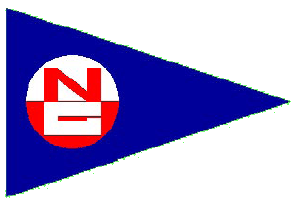
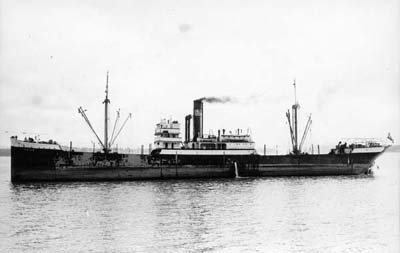 Galea
Built by Astilleros del Nervión, in Bilbao in 1918, was 3,333 GRT.
Galea
Built by Astilleros del Nervión, in Bilbao in 1918, was 3,333 GRT.
On 22 May 1936 together with Cabo Corona y Zurriola, was in the convoy explained when talking about Zurriola.
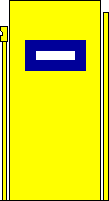
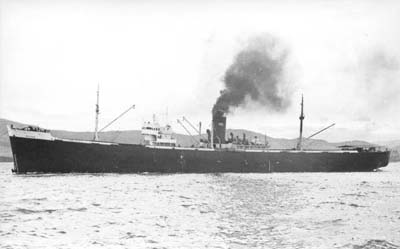 Rio Pas
Built in 1941 by Vickers, in Barrow, as Empire Morn for the Ministry of Shipping, later Ministry of War Transport was a vessel type Y.
Rio Pas
Built in 1941 by Vickers, in Barrow, as Empire Morn for the Ministry of Shipping, later Ministry of War Transport was a vessel type Y.
She had in the forward one with one plane Hurricane to protect herselft of the German planes. This type of vessel was known as CAMS (Carrier Aircraft Merchant Ship). These ships were running mainly in the line to Murmansk carrying supplies to the allied armies. The Empire Morn had a remarkable action in the convoy PQ-18, on Septiembre 1942, bound to Rusia.
On 26 April 1943 touched a mine in position 33-52N 007-50W, in front of Casablanca, destroying the stern as far as to the hold N. 4.
She was towed to Gibraltar where was bought by D. Fernando Maria Pereda Aparicio on 1947, who towed her to Cádiz to be repaired. In the same year left Matagorda to start tramp trading, mainly to America. She was named San Antonio and in the same year changed her name to Rio Pas
In 1963 was sold to Marcosa.
She was broken up in Santander in 1973.
She was 7,092 GRT y 10,000 DWT, with 136.64 x 17.1 meters and triple expansion steam machine.

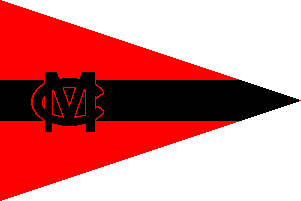

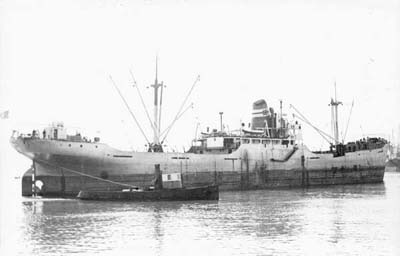 Sendye
Built in 1910 by William Gray, in Hartlepool, as Camerata was 3,723 GRT.
Sendye
Built in 1910 by William Gray, in Hartlepool, as Camerata was 3,723 GRT.
In 1929 was Ronturn an in 1933 became Everards.
In 1939 Empresa Nacional Elcano rechristened her as Castillo Fuensaldaña and in 1957 became Cru Mediterraneo.
In 1961 was bought by Marcosa which changed her name to Sendye.
She was bought by Naviera de Cantabria in 1967 but was heavily damaged by a fire and broken up in Parayas (Cantabria) in 1968.
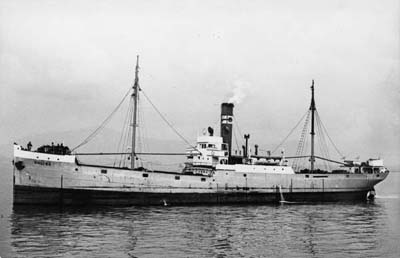 Valira
Built in 1908 by J. Priestman, in Sunderland, as Greenbatt was 1,407 GRT.
Valira
Built in 1908 by J. Priestman, in Sunderland, as Greenbatt was 1,407 GRT.
In 1937 became Stancroft, and in the same year Neoptolemos, but in 1938 became again Stancroft.
In 1941 Empresa Nacional Elcano rechristened her as Castillo Almansa and in 1959 was sold to Marcosa which named her Valira. She was broken up at Avilés in 1967.
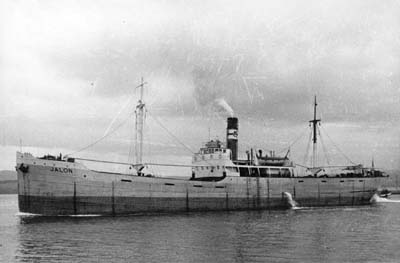 Jalon
Built by S.P. Austin, in Sunderland in 1912 as Hillingdon, was 1,926 GRT and 2,800 DWT. The lenght was 81.38 meters, the beam 11.58 and the depth 6.05.
Jalon
Built by S.P. Austin, in Sunderland in 1912 as Hillingdon, was 1,926 GRT and 2,800 DWT. The lenght was 81.38 meters, the beam 11.58 and the depth 6.05.
In 1920 was Corbrae and in 1934 Nagos.
In 1939 Empresa Nacional Elcano rechristened her as Castillo Monforte and in 1962 was sold to Marcosa which changed her name to Jalon. In 1967 was sold to Naviera de Cantabria, S.A. She was broken up at Bilbao in 1969.
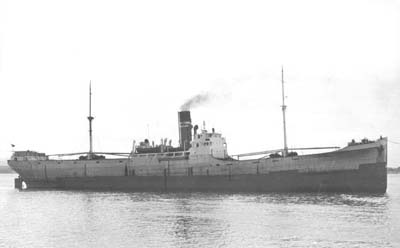 Kogo
Built by J. L. Thompson in Sunderland as Age, changed her name to Kazan in 1935, and in the same year to Lensovet,
Kogo
Built by J. L. Thompson in Sunderland as Age, changed her name to Kazan in 1935, and in the same year to Lensovet,
In 1939 Empresa Nacional Elcano rechristened her as Castillo Bellver and in 1961 was sold to Marcosa which named her Kogo.
It is not clear when she was broken up. She is yet in 1979 Registers.

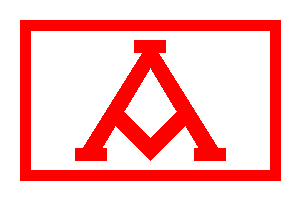
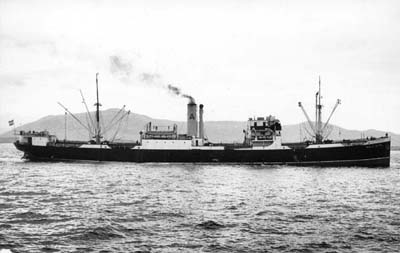 Monte Buitre
Built in 1929 by William Gray & Co. Ltd, West Hartlepool, UK, for Compañía Naviera Sota y Aznar, as Andutz-Mendi with home port Bilbao.
Monte Buitre
Built in 1929 by William Gray & Co. Ltd, West Hartlepool, UK, for Compañía Naviera Sota y Aznar, as Andutz-Mendi with home port Bilbao.
On 10/01/1939 the company changed its name to Naviera Aznar S.A. which rechristened her as Monte Buitre.
She was 1,601 GRT, 3,030 DWT and 98.63 x 11.8 x 5.54 meters, with a triple expansion steam machine of 1,500 HP and 9.5 knots speed.
She was broken up in 1962.
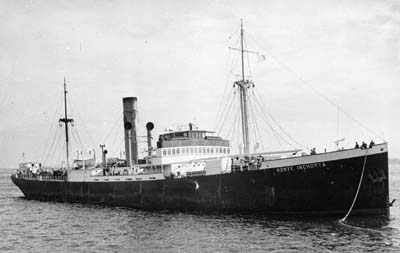 Monte Inchorta
Built in 1921 by R. Ropner, in Stockton on Tees as Alu-Mendi for Naviera Sota y Aznar was 3,350 GRT.
Monte Inchorta
Built in 1921 by R. Ropner, in Stockton on Tees as Alu-Mendi for Naviera Sota y Aznar was 3,350 GRT.
In 1939 when the company changed its name to Naviera Aznar her name was changed to Monte Inchorta. She was broken up at Santander in 1959.
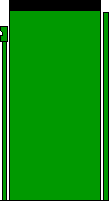
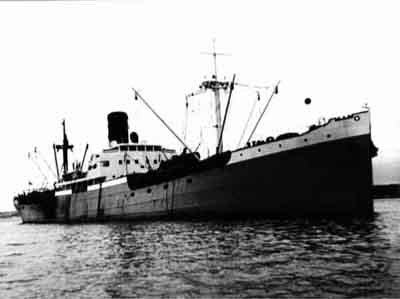 Munisa
Built in 1907 by Charles Connell in Glasgow, was 5,153 GRT and 126 meters long.
Munisa
Built in 1907 by Charles Connell in Glasgow, was 5,153 GRT and 126 meters long.
Her first name was Den of Ruthven, and later Wincote, Kintyre, Polymnia, Sidney, Coruña, Castillo Simancas (since 1939 to 1952), Jarama (to 1960), Rivademar (to 1963) and finally Munisa, with Naviera Forestal Africana.
She was beached near Sinoe (Liberia) on 28/04/72 after stricking rocks when leaving the port, and was abandoned there.
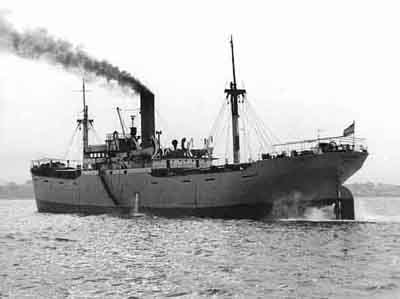 Socogui
Built in 1909 by William Graye in West Hartlepool, ordered by Sota y Aznar, was 4,153 GRT, 2,534 NRT, 6,750 DWT with 111.3 meters lenght, 14.75 beam and 7.68 depth. The triple expansion steam machine had 1,700 HP which gave her a speed of 8 knots.
Socogui
Built in 1909 by William Graye in West Hartlepool, ordered by Sota y Aznar, was 4,153 GRT, 2,534 NRT, 6,750 DWT with 111.3 meters lenght, 14.75 beam and 7.68 depth. The triple expansion steam machine had 1,700 HP which gave her a speed of 8 knots.
Her first name was Eretza-Mendi and replaced to Ama Begoñakoa as school vessel, being on 1917 replaced by the Artagan-Mendi, later renamed as Monte Nuria.
With her drawings were built by Euskalduna in Bilbao two sister ships: Gorbea-Mendi and Umbe-Mendi.
During the Civil War was in the republican band until 1937 when was seized by the Ciudad de Valencia. On 13 April 1939 was renamed as Monte Jata, continuing with the international tramp traffic until 1944 when started the trips to Guinea, which last for almost 30 years, carrying logs to Spain.
On 3 November 1952 was bought by Marcosa and renamed Corisco. On 13 March 1959 was bought by Naviera Forestal Africana and on 13 May 1961 renamed Socogui.
On Junio 1972 was bought by Compañia Marítima Torrelavegense, a company of the Pérez Group, who put her under Naviera Asón flag. She was sailing until Octuber 1973 when the accomodation was on fire, what decided her scrapping.
She was delivered to the shipbreakers at Castellon on 31/10/73.
These last two ships, and several others from the page, were calling at Santander until the 70´s loaded with logs from Guinea.

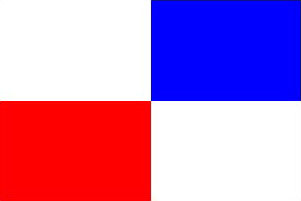
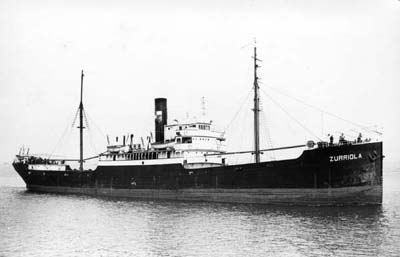 Zurriola
Built in 1899 by R. Thompson, en Sunderland, as Matienzo for Compañia Montañesa de Navegación and with home port in Santander.
Zurriola
Built in 1899 by R. Thompson, en Sunderland, as Matienzo for Compañia Montañesa de Navegación and with home port in Santander.
In 1916 was sold to Compañia Marítima Vizcaína, S.A., keeping the name but changing the home port to Bilbao.
In 1918 was bought by Compañia Naviera Begoña which renamed her as Begoña No.3 and in 1923 by Naviera Guipuzcoana and renamed Zurriola.
On 22 May 1936 in convoy with Cabo Corona and Galea, scorted by the HMS Royal Oak, left Bilbao with 759 children evacuate due to the Spanish war bound to Pouillac, where was retained until 1938.
She was broken up in Valencia in 1964.
She was 1,874 GRT and 3,100 DWT with 84.5 x 12.5 x 5.48 meters and triple expansión steam machine with 740 HP and 8 knots.
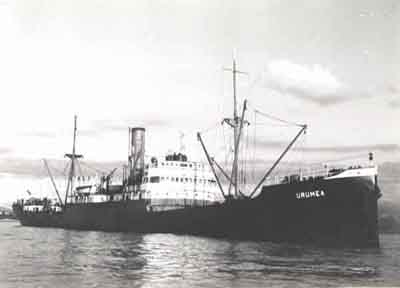 Urumea
Built in 1913 by J.Blumer in Sunderland, was 3,250 GRT and 101 meters long.
Urumea
Built in 1913 by J.Blumer in Sunderland, was 3,250 GRT and 101 meters long.
Her first name was Fairhaven, since 1919 was called San Salvador and since 1928 was Urumea with Cía. Naviera Guipuzcoana of Bilbao.
In 1963 was bought by Cía. Naval de Levante and in 1966 by Cía. Valenciana de Navegación.
She was scrapped on 1967.


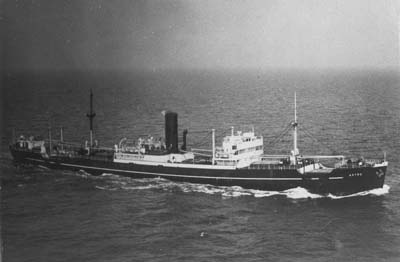 Astro
Built as Danby by William Gray & Co Ltd, West Hartlepool, for Ropner Shipping Co.
Astro
Built as Danby by William Gray & Co Ltd, West Hartlepool, for Ropner Shipping Co.
In the 1952 end was bought by Naviera Astro S.A. (Ángel Yllera) who on 1953 changed her flag to Spain and her home port to Santander renamig her as Astro.
In 1971 was sold to Compañía Marítima del Cadagua S.A., and changed her name to Gopegui and her home port to Bilbao.
On 16/02/76 started to be broken up in Gijón by Manuel Hevia.
She was 7,800 DWT, her dimensions 119.79 x 16.15 x 8.19 meters with triple expansion steam machine with 1,500 HP and 10 knots speed.

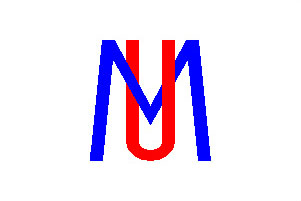
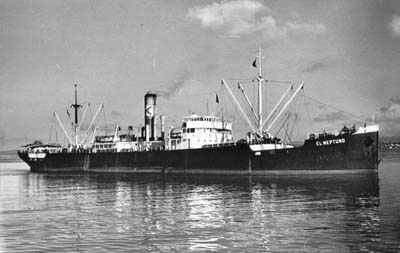 El Neptuno
Built in 1925 by W. Dobson & Co. in Newcastle upon Tyne for Thomas Pratt's Brantingham S.S. Co. as Chatton
El Neptuno
Built in 1925 by W. Dobson & Co. in Newcastle upon Tyne for Thomas Pratt's Brantingham S.S. Co. as Chatton
In 1934 was bought by Compañía Anónima Marítima Unión which rechristened her as El Neptuno, an the home port to Bilbao. Her first trip with Spanish flag was to Buenos Aires.
On 29/03/39 is retrieved in Hull, after the Spanish Civil war.
On 20/10/42 was founded Naviera Bilbaína S.A. merging several shipping companies, one of them Compañía Anónima Marítima Unión.
In 1966 was broken up in Avilés (English sources) or in Bilbao (Spanish sources).
She was 3,569 GRT, 6,860 DWT and her dimensions 113.23 x 15.24 x 7.92 meters with a triple expansion steam machine of 1.500 HP and 9 knots speed.
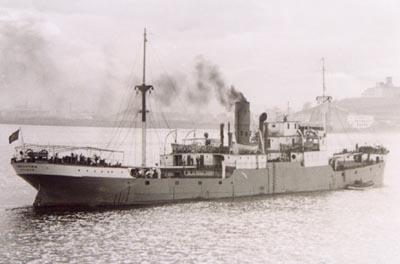 Indauchu
She was built at the United Kingdom on 1920 asMonkton. With 5,112 DWT, her dimensions were 101.0 x 14.2 x 7.7 meters and for propulsion had an triple expansion alternative machine with 1,900 H.P. getting around 10 knots.
Indauchu
She was built at the United Kingdom on 1920 asMonkton. With 5,112 DWT, her dimensions were 101.0 x 14.2 x 7.7 meters and for propulsion had an triple expansion alternative machine with 1,900 H.P. getting around 10 knots.
On 1928 was bought by Compañía Marítima Bilbao and renamed Indauchu.
She kept this name along all her life, except during the Civil War, when was disguised as Sulmona.
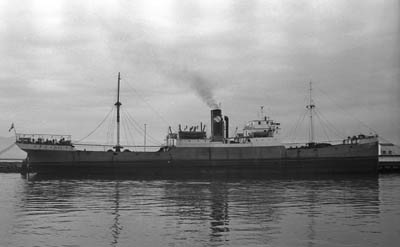 On 1941 was sold to Compañía Anónima Marítima Unión. Ten years later, on 1951, was bought by Compañía Mercantil Anónima Transland, a new shipping company that started with her their activities. On this photo is already with its funnel. She was yet trading for many years, until heading for scrapping on 1971. Instead being scrapped in Spain, as usual, she was scrapped in Netherlands.
On 1941 was sold to Compañía Anónima Marítima Unión. Ten years later, on 1951, was bought by Compañía Mercantil Anónima Transland, a new shipping company that started with her their activities. On this photo is already with its funnel. She was yet trading for many years, until heading for scrapping on 1971. Instead being scrapped in Spain, as usual, she was scrapped in Netherlands.

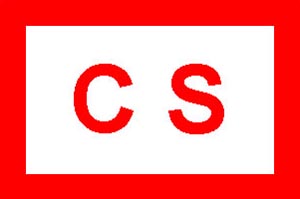
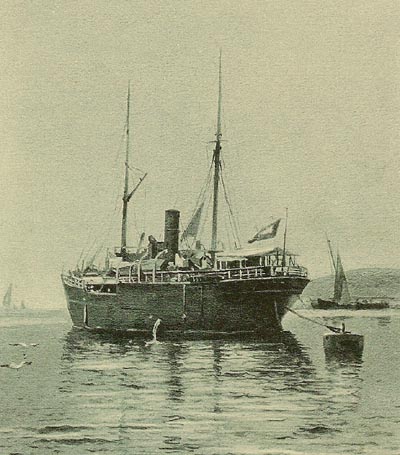 Torre del Oro
She was built in the United Kingdom on 1888 and was bought by Compañía Sevillana de Navegación a Vapor on 1895. Her lenght was 73.15 meters; her breadth 9.8 and her depth 5.2; with a dead weight of 2,236 MT. Her alternative triple expansion steam machine had 731 HP.
Torre del Oro
She was built in the United Kingdom on 1888 and was bought by Compañía Sevillana de Navegación a Vapor on 1895. Her lenght was 73.15 meters; her breadth 9.8 and her depth 5.2; with a dead weight of 2,236 MT. Her alternative triple expansion steam machine had 731 HP.
She was sold on 1918 to José Tayá, but sunk few years later on 1921 near to Menorca.
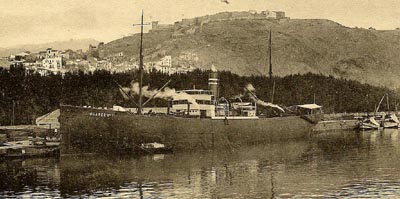 Suarez Nº 1
Built on 1892 in the United Kingdom as Blue Cross, was later renamed Sineus when changing owner. She was 4,500 DWT, with main dimensions of 98.1 x 12.6 x 6.5 meters and triple expansion alternative machine of 1.060 H.P.
Suarez Nº 1
Built on 1892 in the United Kingdom as Blue Cross, was later renamed Sineus when changing owner. She was 4,500 DWT, with main dimensions of 98.1 x 12.6 x 6.5 meters and triple expansion alternative machine of 1.060 H.P.
Marítima Suárez bought her on 1921 and renamed her as Suarez Nº 1. She was the second vessel with this name, the first one being a much smaller ship that was only owned for less than a year.
On 1927 was sold to Naviera Celta and renamed Alfonso Senra.
During the Civil War was under republican control, but was seized very soon by nationalist "bous" and converted in an armed transport until the end of the war.
On 1943 was bought by Gumersindo Junquera and renamed Simancas, keeping this name until being scrapped on 1967.
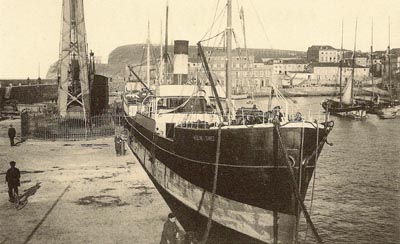 Marcelino Suarez
She was built by Redhead in the United Kingdom on 1874 as Valentino.
Marcelino Suarez
She was built by Redhead in the United Kingdom on 1874 as Valentino.
On 1876 was sold to J. Barreras y Casella, and renamed as Nuevo Primer Barreras. On 1890 was bought by Portilla White and Co. and renamed as Portilla White.
On 1899 was sold to R. Uribarri, and again changed name, this time to Cotillo, and on 1904 was bought by Marcelino Suárez González, radicated at La Coruña, who renamed her as Marcelino Suarez. This name can be seen on this photo, shot at the Punta Lequerica pier (Gijón), and was her last name, because she sunk on March 1913 at El Musel port.
Her hull was made of iron. Her dead weight was 497 MT; with a lenght of 54.4 meters and with a breadth of 7.8 meters.
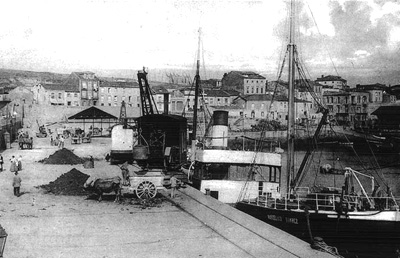 On this photo, shot at same place, she is almost not reaching the pier. There was a big difference in the tide, as can be seen on the background, and propably she was fully laden, opposite to the first fully in ballast.
On this photo, shot at same place, she is almost not reaching the pier. There was a big difference in the tide, as can be seen on the background, and propably she was fully laden, opposite to the first fully in ballast.

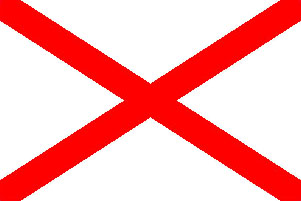
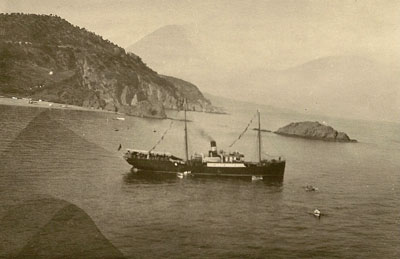 Maria Mercedes
She was built on 1878 in the United Kingdom as Siren for Corporación Trinity
House.
Maria Mercedes
She was built on 1878 in the United Kingdom as Siren for Corporación Trinity
House.
Her deadweight was 648 MT; with a lenght of 57.7 meters; 7.7 breadth and 4.3 depth. Her propulsion was by an alternative compound steam machine with 211 H.P. that was later changed by a semidiesel engine of 235 H.P. She had capacity for 60 passangers.
She was registered in Spain when on 1920 was bought by Luis Liaño Trueba, changing her name to Maria Mercedes, name unchanged until being scrapped.
On 1922 she was sold to Naviera Cabo Páez Hermanos and on 1923 to Compañía Naviera de Navegación Sollerense. On 1928 she was bought by Naviera Mallorquina, being sold again on 1931, this time to Trasmediterránea. This company bought her to avoid competition, laying up the ship until being scrapped on 1935.

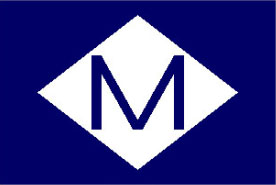
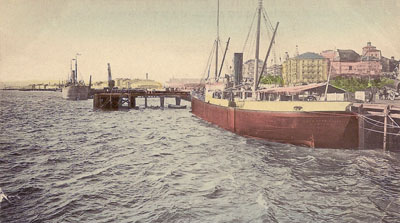 Juan Cunningham
She was built on 1883 in the United Kingdom for La Bética
Empresa de Navegación a Vapor.
Juan Cunningham
She was built on 1883 in the United Kingdom for La Bética
Empresa de Navegación a Vapor.
Her deadweight was 1,415 MT; with a lenght of 67.5 meters; 9.8 breadth and 6.5 depth. Her propulsion was by an alternative triple expansion steam machine with 710 H.P.
On 1906 she was sold to Compañía Marítima, based in Barcelona, but keeping her name. She was scrapped on 1913 after suffering a big damage.
This photo showed her at Santander, just in front of what nowdays are the Jardines de Pereda. On the background to the right is the Cathedral.
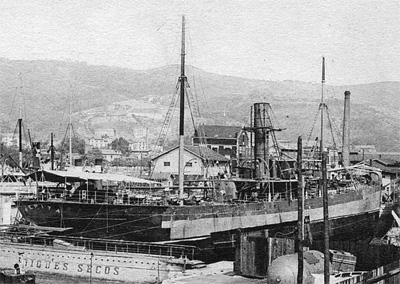 Pepita
She was built on 1888 in the United Kingdom as Cairnryan.
Pepita
She was built on 1888 in the United Kingdom as Cairnryan.
Her deadweight was 2,520 MT; with a lenght of 79.2 meters; 11.0 breadth and 5.0 depth. Her propulsion was by an alternative triple expansion steam machine with 639 H.P.
On 1910 was she bought by Antonio López de Haro Zárate, after getting some damages due to run aground, and renamed Pepita. On 1915 was sold to Compañía Gijonesa de Vapores; and a bit later, on 1916, to Ferrer Peset Hermanos, being renamed as Peris Valero. A year later was bought by Trasmediterránea, keeping the same name until scrapped on 1932.
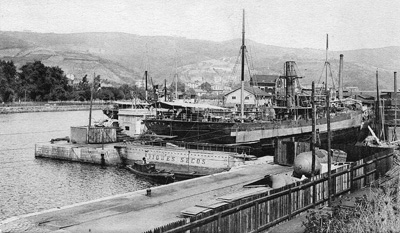 On this photo she was in Euskalduna drydock.
On this photo she was in Euskalduna drydock.
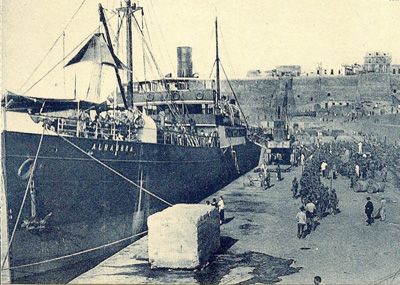 Alhambra
She was built on 1908 by Robert
Thompson and Sons in the United Kingdom for Compañía Anónima de Vapores Vinuesa, with the main office in Sevilla, and named Cataluña.
Alhambra
She was built on 1908 by Robert
Thompson and Sons in the United Kingdom for Compañía Anónima de Vapores Vinuesa, with the main office in Sevilla, and named Cataluña.
Her deadweight was 2.145 MT; with a lenght of 78.1 meters; 10.9 breadth and 7.0 depth. Her propulsion was by an alternative triple expansion steam machine with 950 H.P.
On 1917 she was sold to Trasmediterránea and renamed Alhambra. On 1931 due to the very low charter market she was laid up in Mahón, until bought on 1934 by Ramón Alonso Ramos, who renamed her as Maria R. on 1936. She was the second Maria R.
During the Civil War she was first in the republican side, but was soon seized by the nacionalist.
When the war ended she was returned to her owners, continuing in the coastal trades until scrapped on 1959.
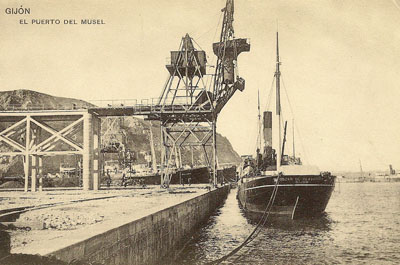 Oscar de Olavarria
She was built on 1887 by Oswald,
Murdaunt and Company Limited in the United Kingdom for Línea de Vapores Serra, and named Benita.
Oscar de Olavarria
She was built on 1887 by Oswald,
Murdaunt and Company Limited in the United Kingdom for Línea de Vapores Serra, and named Benita.
Her deadweight was 1.945 MT; with a lenght of 79.6 meters; 10.4 breadth and 6.3 depth. Her propulsion was by an alternative triple expansion steam machine with 811 H.P.
On 1916 she was sold to Ferrer Peset Hermanos and renamed Felix Pizcueta. Only one year later she was bought by Trasmediterránea not changing her name. On 1919 she was sold to Hijos de Enrique Gironella - Sociedad Anónima Franco
Española de Navegación and renamed Ampurdan. On 1924 she was bought by Ramón Alonso Ramos and renamed Maria R., name that kept until being scrapped on 1936. She was the first Maria R.
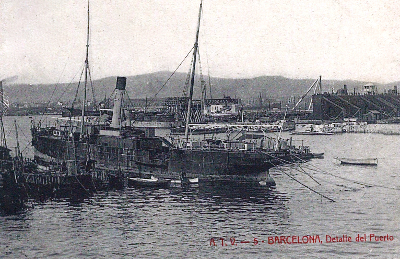 Carlos
She was built as Hebe on 1877 at Trieste by the shipyard Austrian Hungarian Lloyd for its own shipping company, that had the same name. She had 240 MT dead weigth; 253 GRT and y 214 NRT; with 45.1 meters lenght; 5.7 beam and 3.5 depth. The propulsion was by alternative compound machine of 150 H.P. what gave her around 10 knots.
Carlos
She was built as Hebe on 1877 at Trieste by the shipyard Austrian Hungarian Lloyd for its own shipping company, that had the same name. She had 240 MT dead weigth; 253 GRT and y 214 NRT; with 45.1 meters lenght; 5.7 beam and 3.5 depth. The propulsion was by alternative compound machine of 150 H.P. what gave her around 10 knots.
On 1897 was renamed Unione, and on 1902 was bouhgt by A. Galindo registered in Spain and rechristened Carlos. She was for some time trading between Alicante and Oran, and later Barcelona and Vinaroz. In one of these last trips, on 16/July/1905, was grounded at Islas Columbretes to avoid sinking, but she sunk anyway.
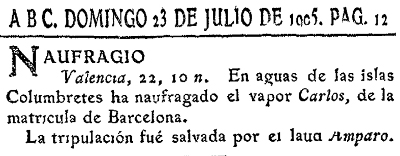
 Spanish version
Spanish version

The information about Socogui is mostly extracted from the book "Los barcos de Pérez y Cía", by Ricardo Alvarez Blanco




































































